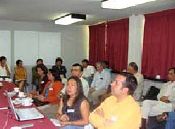| Effects of stones in water-repellent sand |
 |
|
Authors: E. Urbanek & R. A. Shakesby European Journal of Soil Science, June 2009, 60, 412–419
Soils are commonly stony, especially in steep upland or heavily degraded sites. The hydrological effect of large stone contents has been previously investigated in wettable but not in water-repellent soils. For the latter, the focus has instead been on the impact of other soil characteristics (e.g. cracks and macropores) likely to promote water percolation. This paper investigates stone effects on water flow in water-repellent sand under laboratory conditions. Seventy-five experiments were performed on a water-repellent sand mixed with a range of quantities of different-sized wettable and water-repellent stones. The time taken for water to pass through each sand–stone mix, the percolated water volumes and numbers of dry and wet stones following each 60-minute experiment were recorded. At large stone contents (> 55% or > 65% by weight, depending on stone wettability), percolation occurred relatively quickly and in comparatively large quantities. At intermediate stone contents (45–65%) percolation response was variable and at stone contents < 45% for wettable and < 55% for water-repellent soils no water percolation occurred. We argue that with large stone contents flow pathways develop along sand–stone interfaces and a continuous preferential flow path can form provided there are sufficient stone-to-stone connections. The distribution and alignment of the stones, especially at intermediate stone contents, are important for promoting water movement. Water repellency determinations based only on the fine sediment component in stony soils could therefore be misleading as regards determining their hydrological response: the influence of the clastic component must also be considered. © 2009 The Authors
|

Acknowledgement
The DESIRE project was
|
DESIRE brought together the expertise of
26 international research institutes
and non-governmental organisations.
This website does not necessarily
represent the opinion of the
European Commission. The European
Commission is not responsible for
any use that might be made of the
information contained herein. 
